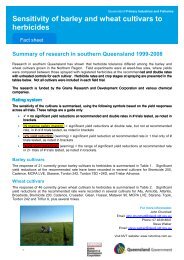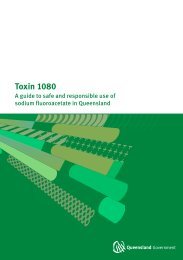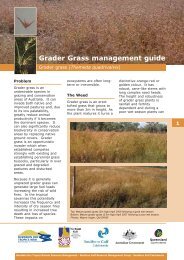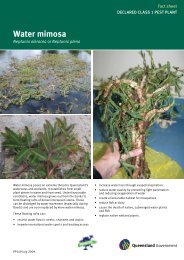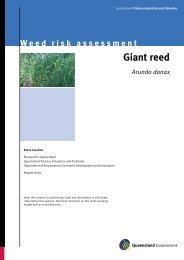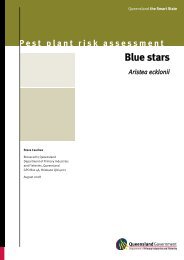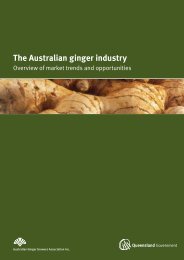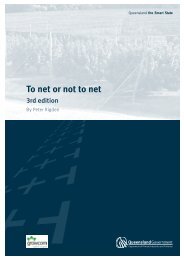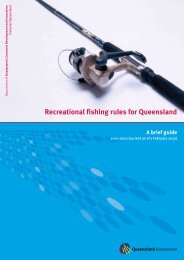Insect Control in Stored Grain - Department of Primary Industries
Insect Control in Stored Grain - Department of Primary Industries
Insect Control in Stored Grain - Department of Primary Industries
Create successful ePaper yourself
Turn your PDF publications into a flip-book with our unique Google optimized e-Paper software.
gas under pressure and is to be applied <strong>in</strong> sealed, gas-tight chambers. Visit BOC Gases website at<br />
www.boc.gases.com/products_and_services/ for full <strong>in</strong>formation.<br />
This fumigant is to be used only by licensed fumigators who hold appropriate State/Territory license, and<br />
are tra<strong>in</strong>ed <strong>in</strong> the proper use <strong>of</strong> required detection devices. It is not to be applied to farm gra<strong>in</strong> silos as a<br />
general use recommendation, by unauthorised, untra<strong>in</strong>ed operators.<br />
Vapormate Fumigant® is approved for control <strong>of</strong> adult stages only <strong>of</strong> Rice weevil, Lesser Gra<strong>in</strong> Borer, Rust<br />
Red Flour Beetle and Psocids. Application rate <strong>in</strong> stored gra<strong>in</strong>s is 420g/m³. Required exposure period is 24<br />
hours. For treat<strong>in</strong>g gra<strong>in</strong> storage premises and equipment, application rate is 420g/m³ and exposure time is<br />
6 hours.<br />
6. <strong>Control</strong>led atmospheres - <strong>Insect</strong> control <strong>in</strong> stored gra<strong>in</strong>s storage us<strong>in</strong>g<br />
controlled atmospheres<br />
<strong>Control</strong>led or modified atmosphere (CA) refers to the process <strong>of</strong> alter<strong>in</strong>g the proportion <strong>of</strong> atmospheric gases<br />
oxygen, nitrogen and carbon dioxide (CO2) to produce a gas mixture toxic to <strong>in</strong>sects. The advantage <strong>of</strong> the<br />
CA technique is that it provides a dis<strong>in</strong>festation method that is chemical-free and suitable for "organic" gra<strong>in</strong>.<br />
A major disadvantage is that it is several times more expensive than fumigation with phosph<strong>in</strong>e.<br />
In practice, use <strong>of</strong> CA's is little different to fumigat<strong>in</strong>g with phosph<strong>in</strong>e. Currently, the only practical method<br />
available to farmers is to <strong>in</strong>troduce carbon dioxide from a gas cyl<strong>in</strong>der <strong>in</strong>to a gas-tight silo. A very high<br />
standard <strong>of</strong> gas-tightness is required, <strong>of</strong>ten with a supplementary bleed <strong>of</strong> gas, to hold at least 60% carbon<br />
dioxide for at least 10 days or 30-40% carbon dioxide for 14 days to kill all stages <strong>of</strong> the <strong>in</strong>sects’ life cycle.<br />
For further <strong>in</strong>formation on controlled atmosphere fumigation, contact the commercial suppliers <strong>of</strong> appropriate<br />
gas and equipment, BOC Gases Australia Ltd, Ph on 13 12 62, or BOC’s website at<br />
www.boc.gases.com/products_and_services/<br />
Contact Organic certify<strong>in</strong>g bodies for specific requirements for organic gra<strong>in</strong>s. You can also get basic<br />
<strong>in</strong>formation on this subject by visit<strong>in</strong>g NSW <strong>Department</strong> <strong>of</strong> <strong>Primary</strong> <strong>Industries</strong> website at<br />
www.agric.nsw.gov.au.<br />
7. Aeration for cool<strong>in</strong>g – to control <strong>in</strong>sects <strong>in</strong> stored gra<strong>in</strong>s<br />
Temperature effects on gra<strong>in</strong> <strong>in</strong>sects<br />
Numbers <strong>of</strong> common gra<strong>in</strong> pests can <strong>in</strong>crease by 20-25 times a month at typical gra<strong>in</strong> harvest temperatures<br />
<strong>of</strong> 30 0 C and gra<strong>in</strong> moisture content <strong>of</strong> 14% for wheat (equivalent to 73% relative humidity (RH)).<br />
Reduc<strong>in</strong>g gra<strong>in</strong> temperature slows <strong>in</strong>sect development. For example, flour beetles can complete their<br />
development <strong>in</strong> three weeks at 35 o C and 70%RH, but take ten weeks at 22.5 o C and 70%RH. Although adult<br />
gra<strong>in</strong> <strong>in</strong>sects live a long time at cool temperatures, their young stages stop develop<strong>in</strong>g at temperatures<br />
below 20 0 C for most species or below 15 0 C for rice weevil.<br />
Aeration cool<strong>in</strong>g can greatly reduce <strong>in</strong>sect and mould activity <strong>in</strong> stored gra<strong>in</strong>, as well as preserv<strong>in</strong>g gra<strong>in</strong><br />
quality. Aeration cool<strong>in</strong>g lowers the temperature <strong>of</strong> gra<strong>in</strong> by blow<strong>in</strong>g cool air through it. An automatic<br />
controller is more effective than thermostats, timers or manual switches <strong>in</strong> select<strong>in</strong>g the coldest air available.<br />
Some growers f<strong>in</strong>d that a comb<strong>in</strong>ation <strong>of</strong> good hygiene and well-managed aeration cool<strong>in</strong>g prevents<br />
development <strong>of</strong> problem <strong>in</strong>sect <strong>in</strong>festations. However other growers have <strong>in</strong>sect problems <strong>in</strong> aerated gra<strong>in</strong>,<br />
particularly <strong>in</strong> summer. Therefore, aeration may need to be used <strong>in</strong> conjunction with other pest control<br />
methods.<br />
Aeration may fail to control <strong>in</strong>sects because <strong>of</strong> heat<strong>in</strong>g <strong>of</strong> the surface layer, particularly <strong>in</strong> summer, or<br />
because <strong>of</strong> <strong>in</strong>sects fly<strong>in</strong>g <strong>in</strong>to the surface layer. Both these problems can be overcome by mix<strong>in</strong>g<br />
amorphous silica (see Table 9 for product names) <strong>in</strong>to the top 30cm <strong>of</strong> gra<strong>in</strong> at the rate <strong>of</strong> 1kg/tonne <strong>of</strong><br />
gra<strong>in</strong>. The amorphous silica is diluted when out-load<strong>in</strong>g to levels that are acceptable to buyers. Pa<strong>in</strong>t<strong>in</strong>g a<br />
silo white can reduce surface gra<strong>in</strong> temperature by 4-5 0 C.<br />
15





